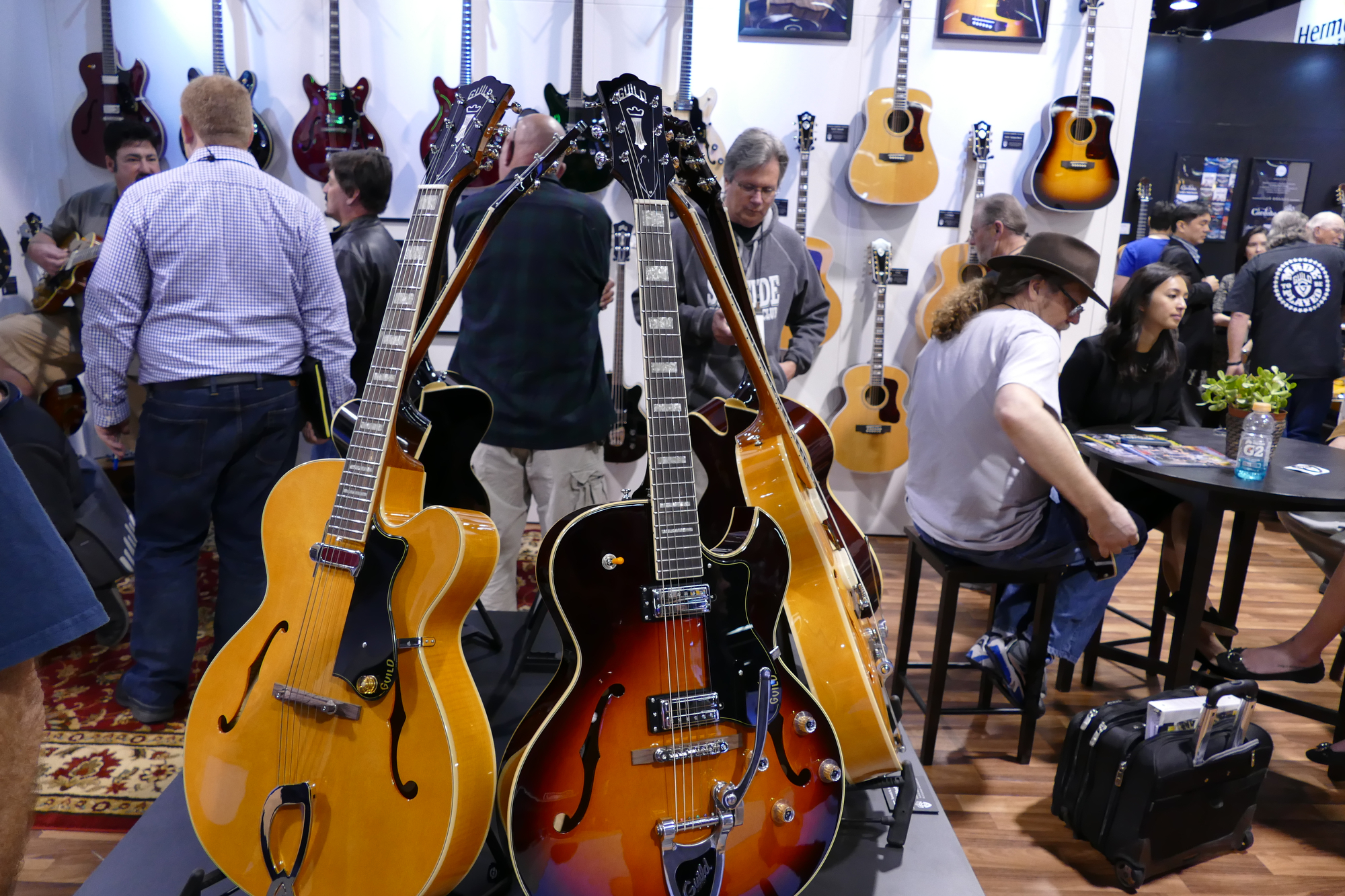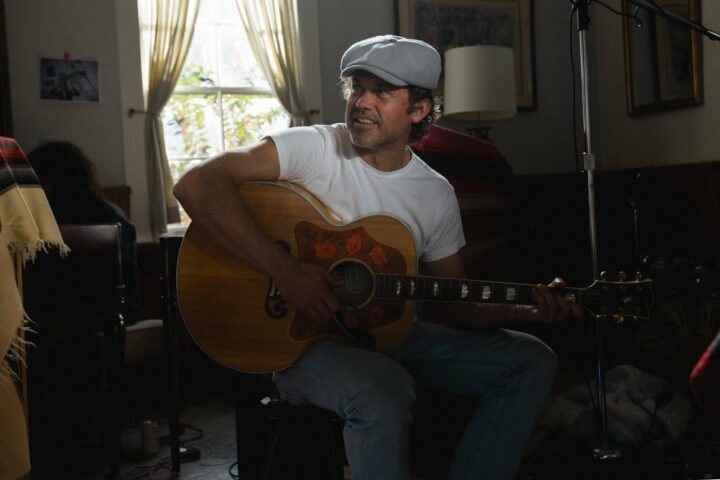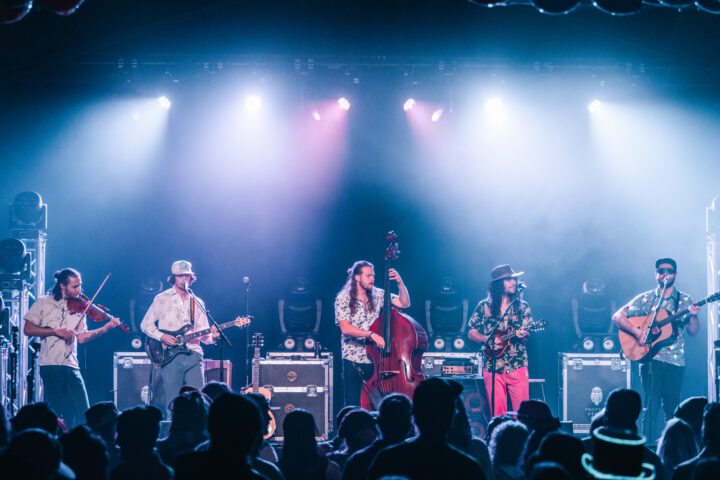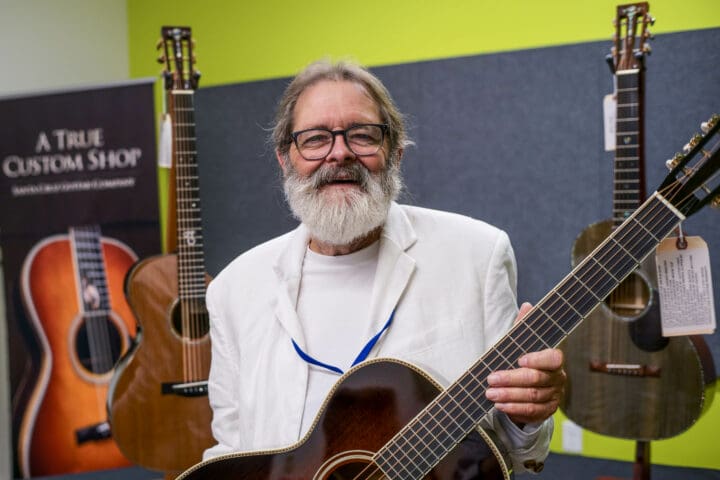Some breaking trends witnessed at last weekend’s NAMM, the annual musical instrument trade show held in Anaheim: 1. Fewer scantily clad (and often downright scary) female models handing out freebie picks (perhaps we’re finally over that chapter of the musical instrument industry). 2. The ukulele gold rush – which seemed to unstoppable during the last few shows – may just be drying up a bit. 3. Torrefied everything on acoustics. 4. At least five strangers recognized my voice from the Fretboard Journal podcasts. Strange times…
And, while there were no game-changer products this year that stopped me in my tracks and had me running for the ATM, it was fun to see some of our favorite brands continue to innovate and evolve. And it was great to catch up with so many FJ contributors, sponsors, subjects, readers and (now) listeners.
Now on to the good stuff…
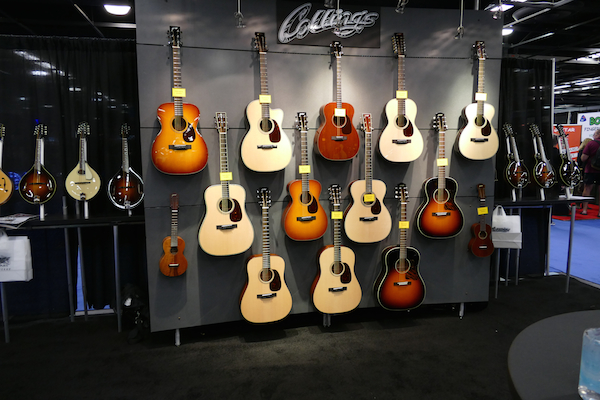
Collings has a new ivory MT2-0 mandolin that will satisfy anyone who yearns for an old Gibson A-3 in Amana white but wants something a bit more refined and modern (we hear the NAMM example is headed to The Music Emporium). On the electric guitar front, Collings showed off a new, solid ash 360 LT electric with twin Lollar Goldfoils and a Bigsby, too (we hear it’s headed to Artisan). Simply beautiful. Our pals in Austin always seem to nail aesthetics and these two instruments were no exception. It’s weird to go into a NAMM booth and want one of everything, but that’s what happens every year with me at Collings.
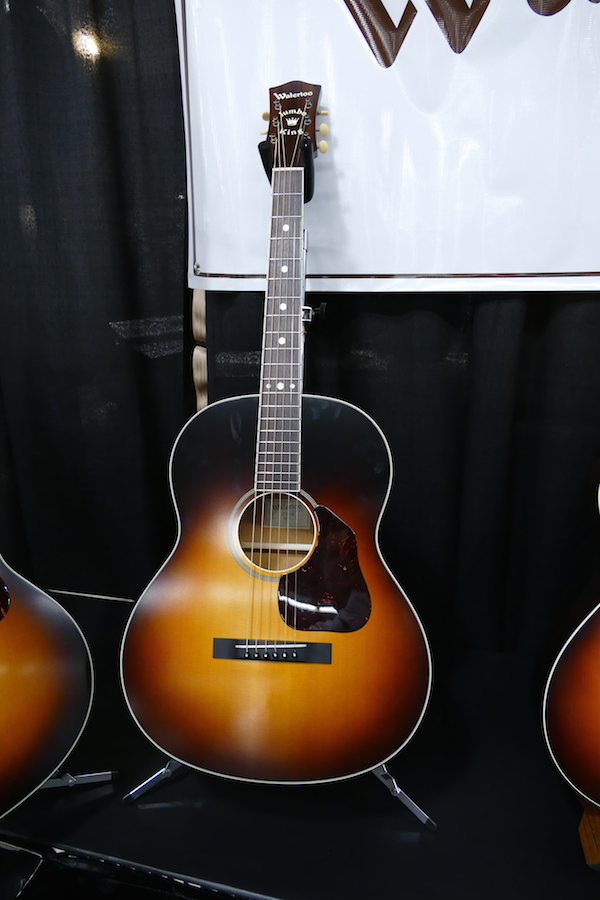
Collings also booked a separate booth for the new Waterloo line of guitars, their line of budget-oriented (yet made in Austin) acoustics. I love both the ladder- and x-braced WL-14 (their take on the old L-00/Kalamazoo KG-14) that were introduced at last year’s NAMM, but the nascent offshoot already has a couple of new models in the pipeline. Waterloo’s Jumbo King pays tribute to those old Washburn/Regal instruments of the ‘30s; Bill Collings even made the “valve cover” tuner covers just like the old Regals. There was also an ultra-light, spruce-topped guitar that paid homage to the legendary (and tough-to-find) Kel Kroydon KK-1. I can’t wait to try one out in a quiet room that is far, far away from the noise of a trade show in Anaheim. The Collings rep told me that these new models require a bit more work than the WL-14, which comes in under two grand. I hope they’re able to make them happen at an affordable price.
In theory, I was supposed to be drooling over the new Private Stock 30th Anniversary Dragons in the PRS room but then I caught wind of another, far cheaper (SE-line) PRS that someone leaked photos of from a back room (I’ll refrain from naming it but you can find it with enough Google searches). It looks vaguely like an updated, restrained take on an old Mosrite and I suspect a lot of folks who don’t normally think of themselves as PRS-types would end up trying it out. Paul, if you’re reading this, I hope that guitar sees the light of day.
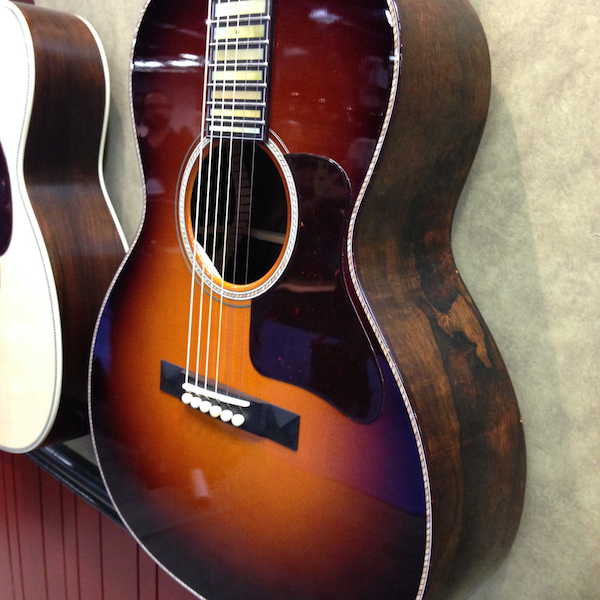
Santa Cruz always pulls out the stops for NAMM with some of their fanciest, bling-filled creations. No matter how expensive their list price, by show’s end the guitars find new homes home with a dealer. This year, Richard Hoover and Co. unveiled a few surprises, but perhaps the most stunning guitar in his array was the custom H/13 (seen above) on display with moon spruce top and gorgeous Brazilian rosewood back and sides. Yes, even Hoover believes there may be something to “moon spruce” (wood that is harvested in Europe based on the cycle of the moon). Big mother-of-pearl inlay markers on the H/13 hinted at the old Gibson Century of Progress, but that’s where the similarities ended. Hoover and Co. are also doing their part to further help out Tony Rice: They had a special Tony Rice signature model on-hand with German spruce and gorgeous Brazilian. Proceeds from its sale go to Tony himself.
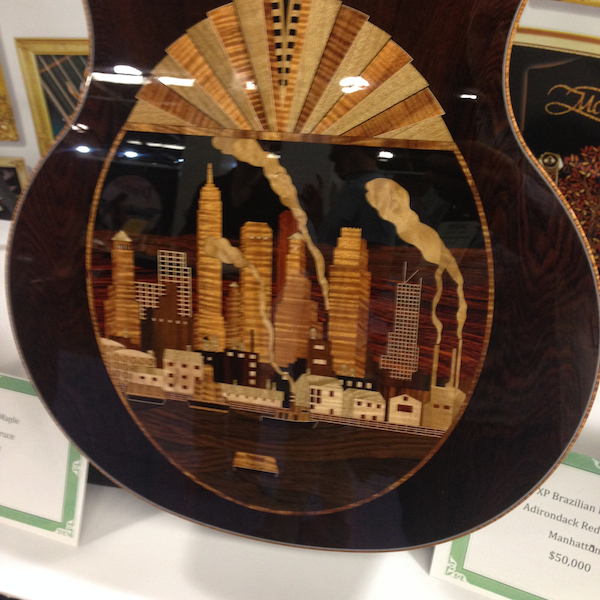
Another wipe-the-drool instrument was being showcased down the hall at McPherson. The $50,000 McPherson Manhattan Skyline was a showstopper. McPherson was also showcasing their carbon fiber Kevin Michael guitars, yet another good option for musicians who like to travel without worrying too much about their guitar’s climate.
Speaking of travel guitars: Did Martin release the affordable and fine sounding backpacker/travel/camping guitar that we were hoping for all these years? They very well may have in the form of the new Dreadnought Junior. It’s cheap (made in Mexico), has a 1 3/4″ nut and it’s all solid wood, basically a dreadnought that was left in the dryer too long and shrunk. It’s an interesting new body style for the typically-conservative brand and I’ll be curious to see if higher-end versions of this little guitar start to come out in the future.
Martin’s most infamous new addition for the 2015 NAMM has to be the CEO-8 that looks more than a little like a Gibson J-200 (the Martin logo was even overhauled for this model to look like it came from Kalamazoo). A bold move from Chris Martin IV that you will either love or hate… I don’t think there’s any in-between here. And then there was Martin’s OM-45 Deluxe Authentic with a price tag of (are you sitting down?)… $100,000. Guitars as expensive as the OM-45 Authentic are always polarizing and this one is no exception. Purists will balk at the torrefied woods, the inconsistencies with the real 1930 OM-45 Deluxe (where are those bar frets?) and that steep price of entry. It’s clear that Martin isn’t trying to do an exacting reproduction of the old classics with Authentics as much as it’s trying to deliver the vintage sound in a compelling new package… an homage of sorts. And, for many buyers and collectors, that’s just what the doctor ordered.
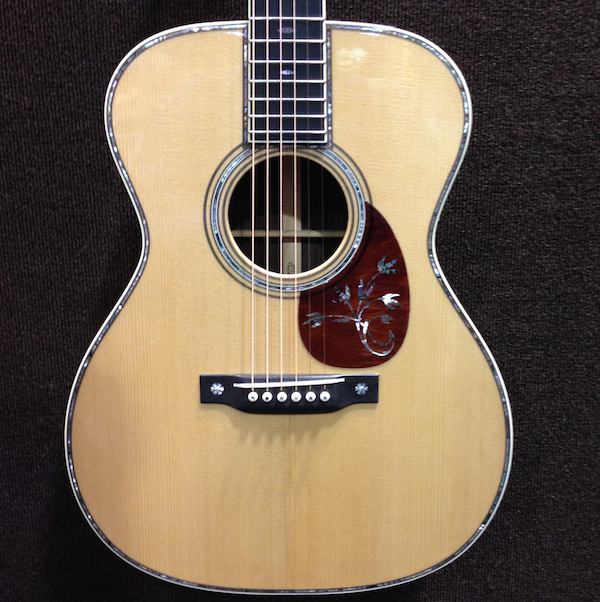
The “T” word – torrefaction – was found all over Hall E, the downstairs section of NAMM where the smaller, higher-end acoustic and electric builders tend to showcase their gear. For those who haven’t followed guitar trends in the last few years, torrefied woods are “baked” in a special kiln, extracting the moisture out of the raw materials. It’s been used for decades in the lumber industry but now guitarmakers are trying it out: It turns out that thermo-curing makes for a more stable, drier Spruce top, one that comes a little bit closer to that broken-in, vintage sound (the top gets a nice suntan in the process, to boot).
While Martin wasn’t the only manufacturer at NAMM championing torrefied woods, they were the best at creating a new catchphrase for the process: VTS. VTS stands for “Vintage Tone System” and it’s Martin’s lingo for their proprietary process to torrefy tops and braces. A quick glance around the NAMM hall revealed that – in addition to tops and braces — backs, sides and even necks are getting the kiln treatment, too. Is this the future? And what will happen to these pre-baked tops in 20 or 30 or 70 years? Time will tell…
Now back to the guitars…
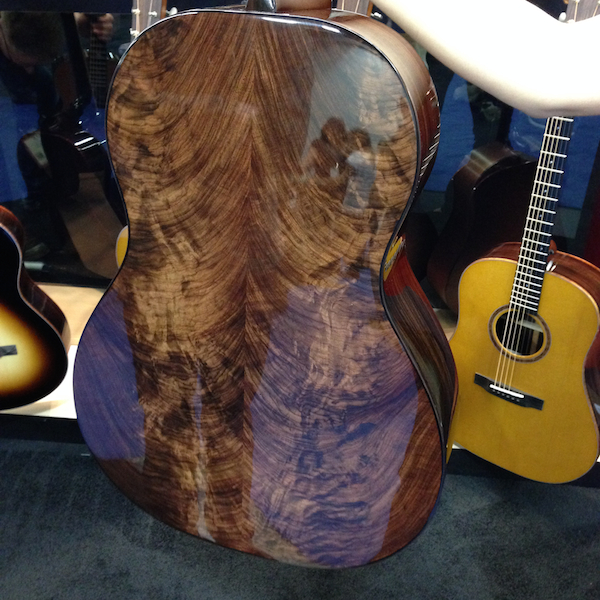
Bedell is slowly working their way through the giant stash of legal Brazilian rosewood they procured a few years back. They had some truly stunning guitars on-hand, such as the one seen above. To ease long-term travel / shipping concerns, each Bedell now comes with a “journal” documenting where the instrument’s woods came from. You can even request a US Fish & Wildlife passport for your guitar directly through the Bedell site. Closer to home, Bedell’s Earthsong series features guitars built exclusively with North American woods. Heck, they even now have a vegan guitar! (Which maker will step up and make a Paleo guitar?)
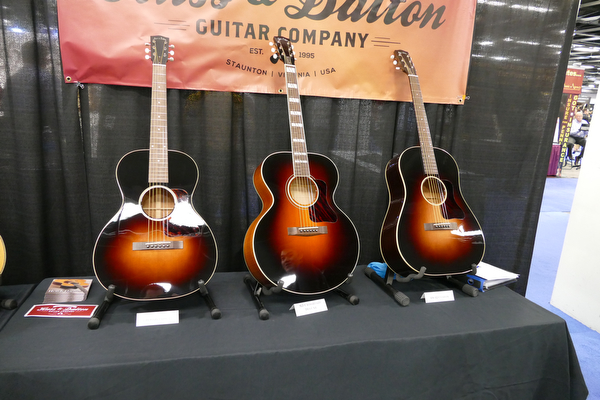
Huss & Dalton celebrated their 20th anniversary with a gorgeous prototype CM with sinker mahogany and a thermo-cured (yep, torrefied) Red spruce top. They also had a stunning trio of sunburst instruments on hand: a Crossroads 12, an MJ Crossroads Deluxe and a DS-12 Custom.
Taylor continues to energized by two factors: Bob Taylor’s quest for sustainable (and alternative) tone woods and the lutherie prowess of Andy Powers. Their new 600 series combines both initiatives. The new 600 series of guitars is all about maple, a wood that is plentiful in the Pacific Northwest and, as Powers has shown, can be made to look (and sound) like more traditional back and side woods. Yes, the new 600s have torrefied Spruce tops, too.
Dana Bourgeois pulled out all the stops for his 7000th guitar, a Brazilian dread with a tree-of-life inlay, torrefied (of course) Adirondack top, torrefied braces, hide glue and gold Waverlys. This was no straight-grained affair… it had some of the wildest Brazilian I’ve seen in a while. I hear it’s headed to The Music Emporium. Also cool: a Custom 0 with “Aged tone” (that’s torrefied, again) Adirondack spruce and Brazilian. Price: $14,445. Before leaving the show, Dana and I agreed to do a future podcast all about the torrefication process. Look for that soon on fretboardjournal.com.
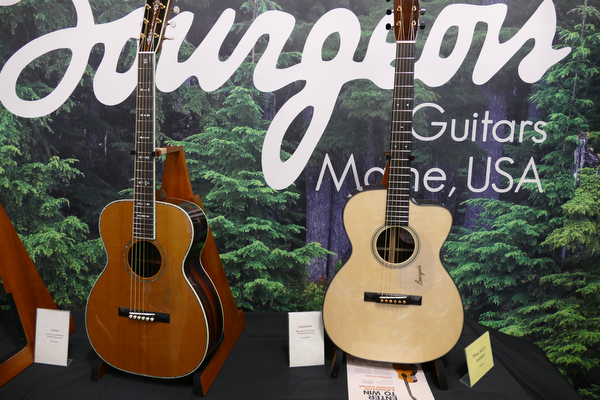
On a much cheaper note, the guys behind Saga also had a new dreadnought to show off: a signature John Jorgenson flattop. The Blueridge Jorgenson model featured an enlarged soundhole (a la Tony Rice’s but not quite as large), a rosewood laminate back and sides and an unlikely top wood: Port Orford cedar. It has a little bling in the form of a desert rose inlay but you’d still be accepted at most bluegrass jams with it (the same can’t be said for Jorgenson’s red wine-colored Takamine signature model).
Guild is back… with new owners Cordoba Guitars. And it looks like they’re determined to not only to resurrect the acoustic designs Fender was working so hard on but also the electrics and archtops, too. Beyond the familiar Guild flattops, we saw a variety of classic Guild archtops on display and even a white S-100, a la Kim Thayil. It’ll be interesting to see this brand ramp up.
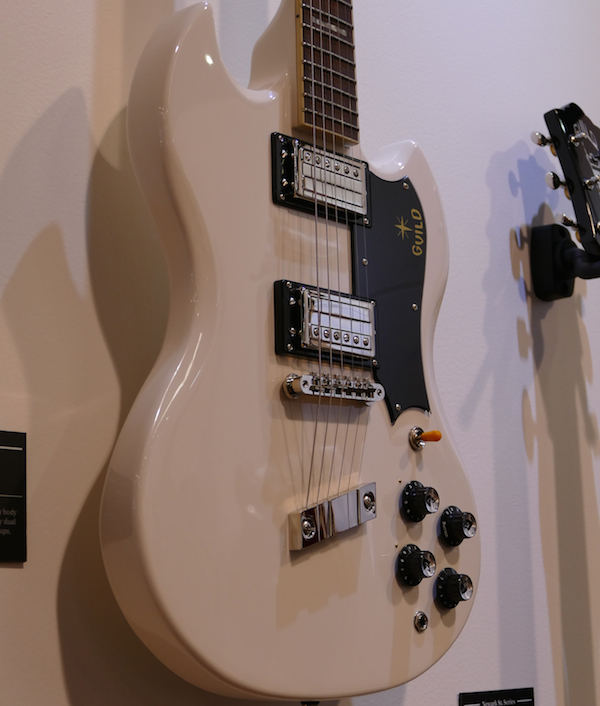
Yes, Fender did have a million dollar Strat on-hand. Encrusted in diamonds and based on a Faberge egg. It was just one of the many Custom Shop creations on display. They also debuted a new humbucker from Tim Shaw (best known for his pickup work at Gibson) called the Shawbucker. On completely different note, Fender released a new Concert Tone banjo, the sleeper banjo line that they produced in the ‘60s and ‘70s. I don’t know if the world needs another banjo maker but the old ones sure were cool.
No surprise to anyone, Gibson continues to evolve, looking more and more like a technology company every day. The Gibson room at NAMM was huge but focused largely on their stereo, turntable, microphone and headphone offerings. They showcased a new Bee line of microphones — built by the founders of Blue mics) — that looked IKEA-esque in their yellow and black color schemes. Oh…and there are now Les Paul signature headphones, too. On the good ol’ guitar front, there was a bit of a hollowbody theme going on: Epiphone was offering a new Gary Clark, Jr. signature “Blak and Blu” Casino that looks like a great bargain. And Gibson themselves have a new ES-335 Studio, which is made in America and has a list price of $1600. For an official Gibson USA product, that’s a downright bargain (it even has non-robotic, old-fashioned Grover tuners).
The guitar world’s love for effects pedals – especially boutique effects pedals – continues to grow. Happy to see all of the excitement (and crowds) around booths from Z.Vex, Earthquaker Devices, Strymon and others. Though we tend to focus more on the acoustic things around these parts, it’s hard not to be impressed by the sheer quantity, quality and diversity of today’s stomp boxes… and the craft that goes into them. Whether you’re trying to recreate a lost amp from the ‘60s or come up with some insane looping creation from the future, someone is busy at work trying to help you get there. Exciting times.
I felt the same buzz (no pun intended) walking into the Premier Builders Guild booth, where Saul Koll and Dennis Fano are creating some of most forward-thinking and beautiful electrics around.
As always, the real NAMM highlight for me was catching up some of my favorite people. You can look at new guitars all day long but it never matches hearing Bill Collings or Dick Boak or Bob Taylor talk about the craft of making them. And then there are all the random people you see at NAMM: I’m not sure why independent luthiers such as TJ Thompson, Jason Kostal, Kathy Wingert or Frank Ford come to a show like this but it sure is nice to bump into them.
The funny thing about a giant trade show like NAMM is that the minute you walk in, your eyes glaze over and the minute you leave, you hear about all the great stuff you somehow neglected to discover. But the above is what caught my eye. If you were at NAMM and saw something worth talking about, feel free to leave a comment below.
